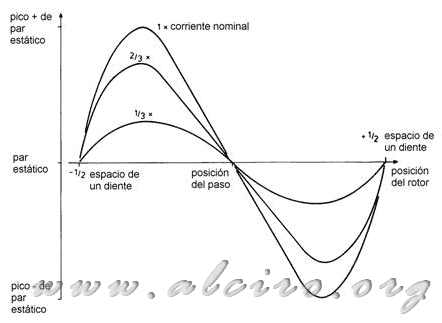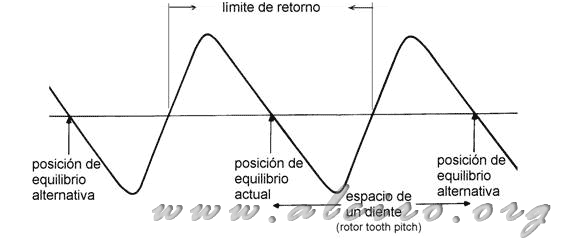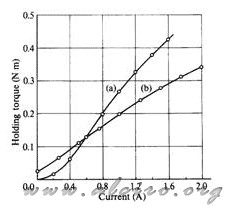2. CHARACTERISTICS OF STEPPER MOTORS
2.1. Static characteristics
The characteristics of the motor in steady state is called static characteristics.
2.1.1. Holding torque (Holding torque)
When feeding the engine, and in sleep need a certain amount of torque to the rotor one step forward, this is known as holding torque or (Holding torque) and is specific for each engine. Usually provided by the manufacturer in the specifications. When you apply a torque that exceeds the holding torque the rotor rotates continuously. The holding torque is usually higher than the pair of work and acts as a brake, keeping the load in place.
The static torque developed by a motor is a function of rotor position, the dimensions of the stator and rotor teeth, and the value of current flowing through the windings. The typical response curves of a VR motor shows us the figure 3.1, the hybrid engine are very similar.

Figure 3.1 static torque characteristic curve for various intensities, with an engine with a variable reluztancia
In the step position, the teeth of the rotor and stator are perfectly aligned and there is no pair. If the rotor is moved off the position of equilibrium develops a force between the teeth of the rotor and stator, forming a pair that pushes the rotor to return to the position of the step. When the direction of movement of the rotor is negative produces a positive torque occurs when positive and negative torque.
Figure 3.2 shows the torque characteristics to the space of a tooth of the rotor (rotor tooth pitch). The rotor position only returns to its original pitch if it is not moved more than half a rotor tooth pitch.

Figure 3.2 Characteristic of static torque with the step position at rated current.
The engine torque produced is proportional to the current through the phases, for variable reluctance motors for hybrids, as seen in Figure 3.3 features torque / current, the torque is proportional to the intensity with some linearity.

Figure 3.3. Example of characteristic torque / current. (A) variable engine reluztancia four phases and 1.8 °, and (b) hybrid motor







